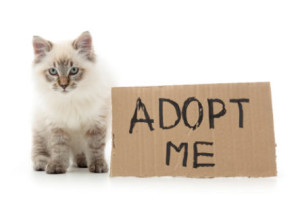Posts Tagged ‘veterinary care’
Should I Adopt A Cat Or A Dog?
 It is always a good time to adopt pets, but June has been designated cat adoption month. By far the most common pets are dogs and cats. If I asked a person the difference, I would probably get a strange look and an answer like “one barks and growls, where the other meows and purrs.” But there are other differences that affect them as to whether they may be the right pet for your family.
It is always a good time to adopt pets, but June has been designated cat adoption month. By far the most common pets are dogs and cats. If I asked a person the difference, I would probably get a strange look and an answer like “one barks and growls, where the other meows and purrs.” But there are other differences that affect them as to whether they may be the right pet for your family.
First off, dogs need to be cared for, whereas cats are independent. Dogs are descendants of pack animals. Dogs like company and will never be bored if one spends a lot of time with it. Their pack mentality allows the dogs to be trained more easily as they crave attention. On the other hand, cats love to spend a lot of time alone. Cats are solitary hunters that are more attached to their environment than they are to other cats.
The pack behavior also relates to how a dog is built physically. In the wild they are designed to run down their prey. This translates to dogs being built as long distance runners. Dogs need a lot of space as they love to run around. Cats are designed to stalk their prey. Their instincts lead them to sneak up on their prey and then pounce. This leads to cats being built more as sprinters rather than long distance runners. Contrary to dogs, cats are very happy in small places.
When looking at the nature of dogs and cats, the former loves to please you, but the latter always love to please themselves. Well, dogs are more affectionate when compared to cats. Dogs will wag their tail, and even their whole body, to show affection. A cat will only show affection by allowing you to scratch it behind the ears.
Unlike dogs, cats are lap animals. A cat will tolerate being smooched, but on the other hand, you will be smooched by a dog. Dogs are happy to see you when it is awaken from sleep, but a cat will just pretend to be sleeping, even if you try to wake it.
Dogs tend to be your friends at night and protect you from harms way by scaring the intruders. Cats, they will just run for cover.
By knowing your lifestyle, you can determine what pet is best for you. Dogs are more social, require more attention and space. Cats on the other hand tend to be happy being by themselves and don’t require as much attention and space. Both species can be rewarding pets.
If you have any questions about the right pet for you, please contact our office!
How Do I Know If My Pet Has Rodenticide Toxicity?
 With the cold weather upon us, many other four-legged friends such as mice are taking up refuge in our houses trying to keep warm. In order to control this problem, many happen to go to our local hardware store and put out rodenticides. Unfortunately, several of our curious pets may venture upon the “mouse bait” and ingest it. This can cause serious problems which can include death if not noticed and proper treatment received.
With the cold weather upon us, many other four-legged friends such as mice are taking up refuge in our houses trying to keep warm. In order to control this problem, many happen to go to our local hardware store and put out rodenticides. Unfortunately, several of our curious pets may venture upon the “mouse bait” and ingest it. This can cause serious problems which can include death if not noticed and proper treatment received.
There are several different rodenticides such as anticoagulants, bromethalin, and cholecalciferol that are used and they all attack different body systems. So it is important to know the active ingredient so that proper treatment can be implemented.
Signs of rodenticide toxicity do not show up for several days and sometimes are very subtle and unrecognized. The most common sign may be bloody saliva in your pets water bowl. If you suspect that your pet has ingested the poison, it is best to seek medical attention as soon as possible. Take the poison box with you. That way the veterinarian can see which product has been ingested and proper medications will be given. Your veterinarian will want to induce vomiting as soon as possible, including giving activated charcoal to reduce the absorption of it in the stomach. Other products such as Vitamin K, or lasix may be giving depending on the poison. Bloodwork and a urinalysis will be done to assist the veterinarian with the diagnosis and prognosis.
A quick and easy recipe to use for getting your dog to vomit would be to give your dog one to two slices of white bread and then give a mixture that consists of 3 tablespoons of Hydrogen Peroxide, and 1 tablespoon of peanut butter. Wait 10 minutes to see if your pet vomits. If it doesn’t repeat it again.
As the old adage says, an ounce of prevention is worth a pound of cure. It really holds true here. To create a safer environment for your pet, prevent access to areas where you lay poisons for mice. Keep garage doors shut, cabinets closed, and lock the basement. Never put poison outside near your dog’s run, and should you find dead rodents, remove them immediately. Ingesting a poisoned mouse can be just as toxic as eating the poison from the trap.
If you have any other questions, don’t hesitate to contact our office.
Tips For Taking Care of Your Aging Pet
 Regular professional veterinary care is essential to the health of your older pet. Not since your pet was a puppy or kitten have regular check ups and vaccinations been so important. Preventive veterinary care can add years and quality to the life of your older pet. Consider yourself, your pet, and your veterinarian and staff a team whose main goal is to keep your pet happy, healthy and in a loving relationship with your for as long as possible.
Regular professional veterinary care is essential to the health of your older pet. Not since your pet was a puppy or kitten have regular check ups and vaccinations been so important. Preventive veterinary care can add years and quality to the life of your older pet. Consider yourself, your pet, and your veterinarian and staff a team whose main goal is to keep your pet happy, healthy and in a loving relationship with your for as long as possible.
Dogs and cats are living longer than ever and that phenomenon is directly related to the fact that today people take such good care of their animals. Important changes affecting 85% of pets today, with a focus on nutrition, rapidly advancing veterinary care and loving environments are responsible for the life expectancy of animals to be extended, in general, a five years longer across the board than was previously the norm. The human-animal bond is strong. Many people today take fantastic care of their pets and have educated themselves on the best protocols for these important friends. Every aspect of how to care for the family pet is considered in terms of diet, vacations, exercise, entertainment, grooming, wellness comfort, aging and more.
Three important aspects of the aging pet we consider are:
Diet: Obviously starting early is important. Two things can happen to the aging patient: becoming either over or under weight. It is easier to prevent a pet from being overweight than it is to diet him but we are successful at helping the committed owner who wants to help their pet lose weight. This involves selecting the correct snacks, as well as the appropriate food. The underweight and aging pet can be a bit more of a challenge and the underlying causes must be diagnosed but in most cases we can help clients maintain a healthy weight in the elderly pet. One of the most important aspects of diet in the geriatric pet is being aware of the changes going on with respect to his or her vital organs and metabolism and selecting the best diet, supplements, and snacks for his or her particular condition.
There are several prescription foods available that directly target the aging brain. We would be happy to discuss and make recommendations of the excellent choices that are out there.
Preventative Care: As you are aware, pets are very stoic in the face of considerable disease and one of the difficult aspects of care in veterinary medicine is the fact that we ofter do not see the pet until a disease process is very advanced. A well-thought out and followed preventative plan is a great way to minimize testing and monitoring and can offer tremendous insight to what is going on inside the pet. There are medications available that target the diseases and changes that adversely affect the older patient and we can guide you toward those after an evaluation that will tell us if your pet is in need of preventative care.
It is very comforting to pet owners when an elderly patient has a normal physical exam and consult, blood pressure, ECG, and urinalysis. We ask specific questions to discern if there are subtle changes in the animal that might lead us to want further diagnostics.
Exercise: Exercise should be maintained for the elderly patients. Did you know that 15 minutes 3 times per week of forced exercise will go a long way in maintaining a healthy metabolism in your friend? As with diet, exercise should be implemented at a young age and adjusted as the pet ages.
Cognitive function can be supported in the geriatric pet with specific supplements and there are medicines available if your friend is found to be in need. Antioxidants, healthy fats, and pain medications can keep the old aches and pains away just like us! Certain activities and ideas to encourage the older pet and suggestions to protect them, especially when he or she is alone, are available if your need them.
Older pets need regular veterinary care to prevent disease and/or diagnose it early in its course. Many veterinarians have special programs to monitor dogs in their later years of life. Good communications between the owner, dog and veterinarian can keep the pets healthy and make their senior years to be wonderful years. At the end of your pet’s life, your veterinarian can help you in making decisions, provide support, understand and share your grief and celebrate, with you, the life of your pet.
As always, the health of your pet is of utmost importance at our office. Please CONTACT US if you have any questions.
October is National Pet Adoption Month
 October is National Pet Adoption Month and many people constantly are adopting pets from rescue organizations. Peoples lives are enriched in ways that they have never dreamed possible. Bringing home a new pet is such an exciting and fulfilling experience, but it can be a bit daunting as well, especially if you have never shared your home with a furry companion. Here are some tips to get your relationship off on the right foot.
October is National Pet Adoption Month and many people constantly are adopting pets from rescue organizations. Peoples lives are enriched in ways that they have never dreamed possible. Bringing home a new pet is such an exciting and fulfilling experience, but it can be a bit daunting as well, especially if you have never shared your home with a furry companion. Here are some tips to get your relationship off on the right foot.
Be prepared Before you bring your pet home, determine where your pet will be spending most of its time. Because it will be under a lot of stress with the change of environment, it may forget any housebreaking it has learned. An area with tiled, pergo, or linoleum floors may be best because it is easiest to clean up. You will also need to dog-proof the area where your pet will spend most of its time. This may mean taping loose electrical cords to baseboards, storing chemicals on high shelves, removing plants, rugs and breakables. The more prepared that you are, the smoother your new family member’s transition will be.
Shop for the basics You will need a leash, collar, food and water dishes and of course food. It is best to know what your new adoptee is eating as an abrupt diet change can cause diarrhea and other problems. If you change its diet, do it as a gradual change like maybe over 10 to 14 days. One other thing to buy is a medal id tag. It does not replace microchipping, but it does help some. If you are planning on crate training your pet, it is best to wait and take your pet with you to purchase it. This way you will get the proper size.
Consistency Make sure all family members are on the same page. Ground rules need to be set and the family members need to agree to follow and enforce them. For instance, if you don’t want your new pup on the couch, all the training in the world won’t help if your child lets it sit there with you when you are not home. Also, caring for your pet is a family effort and endeavor, so it is important that everyone understands their particular roles and responsibilities.
Adjustment Over the first few days to few weeks, your new pet will be undergoing an adjustment period. These surrounding are new to him, so you may notice some anxiety issues that may include appetite loss or suppressed bowel habits. It may even hide under or behind furniture or stay in one room. Don’t be alarmed-this is absolutely normal behavior. Give the pet time to acclimate to your home and family. By showing patience, you will help it through a tough, scary time and it will show the pet how wonderful his new home really is.
Set Schedule It is best to set a schedule for feeding, toileting and play/exercise. From Day One, your dog will need family time and brief periods of solitary confinement. Don’t give in and comfort it when it whines when left alone. Instead, give it attention for good behavior, such as chewing on a toy or resting quietly. By sticking with a schedule that you created, your pet will be bonded with you in no time and the pet will be showing its true personality.
Veterinary Care Schedule a first visit to your pet’s veterinarian during the first week. Bring any and all medical and vaccination records that were supplied by the shelter or rescue from which you adopted your dog. This first visit os a great time to get clues about your pet’s personality and past history, so don’t be afraid to ask lots of questions. Also, if your pet is not microchipped, this is a good time to do it because true love is hard to replace.
Congratulations! If you follow these tips, you’ll be on your way to having a well-adjusted family member. Make sure to contact us if you have any questions!
